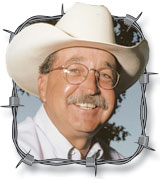When I grow up, I want to be a weatherman. What else, besides being an economist, can you be wrong more than 50 percent of the time and still keep your good-paying job?
My memory could have faded with age, but it seems to me that the old weatherman (I understand they like to be referred to as meteorologists today) that my father listened to every morning on the old cabinet-styled AM radio was pretty good at predicting the upcoming chances for rain. If “Earle” said we were going to experience three to four days of clear weather, Dad would hook up the mowing machine and cut as much hay as he could with a six-foot, sickle-bar mower. We seldom got any rained on, but late in his lifetime, as “meteorology” became less and less reliable, he would simply cut hay when the hay was ready – as long as it wasn’t raining that day. He was about as fortunate with that methodology as he was listening to the “Earle” of my youth.
Today, I can listen to the weather band radio, provided by the U.S. Weather Service, in the cab of my tractor as I mow hay. I have to laugh at their “20 percent chance of precipitation” every day, even when we’re in the midst of a summer-long drought. If the reception is bad on the radio, I can pull up real-time radar on my hand held cell phone and see that there are showers occurring thirty miles west of me. Of course, that doesn’t mean they will actually make it to my farm.
A lot of my farmer friends have their own prognostication techniques. One such friend makes note of “mare’s tail” clouds. They are the ones that are long and wispy and resemble the tail of a horse. He is adamant that when these clouds are observed in the sky, it will rain at that location within 24 hours. I’ll have to admit that he’s right more than 50 percent of the time.
Another friend, that I used to work for in my younger days, simply gets the daily newspaper and finds what the weather is like in Wichita, Kan., today. “We’ll get their weather tomorrow,” is his simple observation. Again, he is correct more times than he is wrong.
I’ve written before about my method. I count turtles on the highway between my home and a farm I own about five miles north. Every turtle (alive or dead) in that five mile stretch equates to ten percentage points on the probability of rain. If I see ten turtles, I simply take the day off and head to the local sale barn. Trust me; it’s more accurate than our current staff of “meteorologists” on ALL the local television stations.
Actually, I’ve had pretty good luck in my haying adventures this past spring and early summer. The only hay I’ve gotten wet was on the third day of a predicted “five days of absolutely no chance of rain” forecast by the local weatherman. I was baling hay in a 40-acre field and was almost finished, when some dark clouds started boiling up in the south. I grabbed my cell phone and logged on to the instant weather. I was relieved to see absolutely nothing showing up on the local radar. Two minutes later, it was pouring down with such intensity, the wipers on the tractor couldn’t let me see the windrow I was trying to straddle. I ejected the bale, shut the tractor down and logged on again. One red speck on the radar showed my exact location.
That evening, I watched the 10 p.m. news and weather to hear the meteorologist gleefully say, “Wow, those pop-up showers we experienced this afternoon surprised everyone!”
I had seen five turtles on the road that morning, but I already had the hay down.
Jerry Crownover is a farmer and former professor of Agriculture Education at Missouri State University. He is a native of Baxter County, Arkansas, and an author and professional speaker. To contact Jerry call 1-866-532-1960 or visit www.ozarksfn.com and click on ‘Contact Us.’






